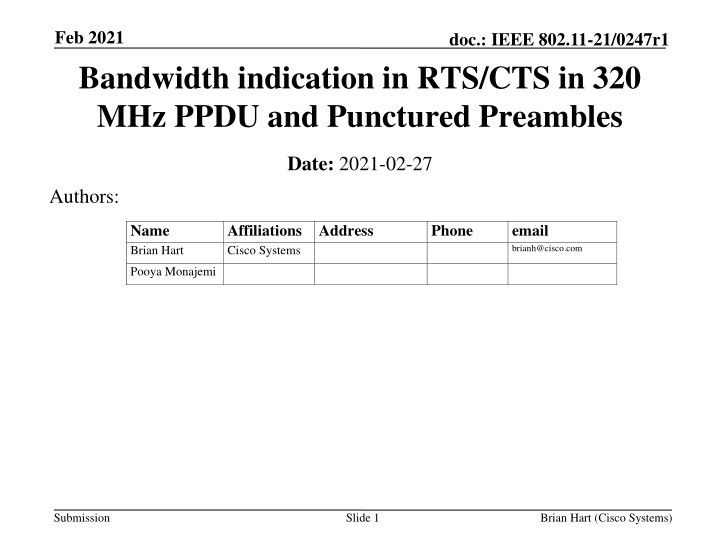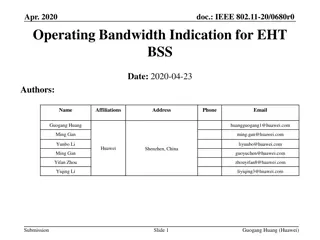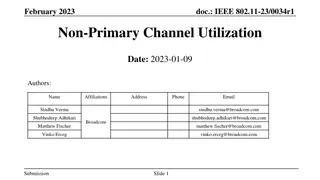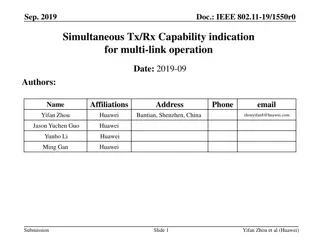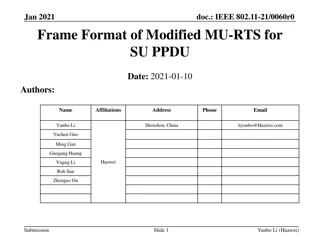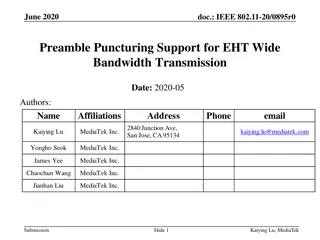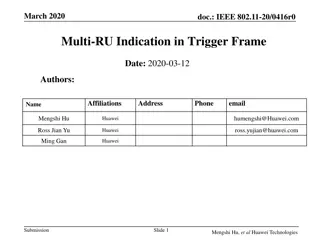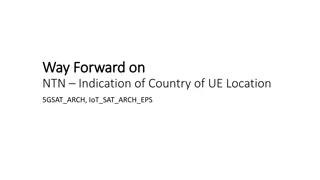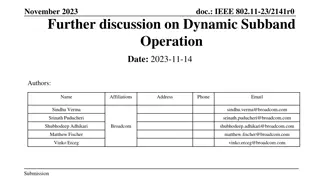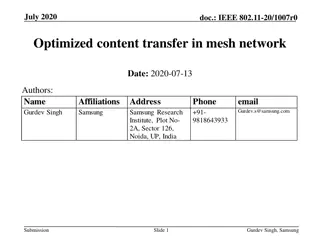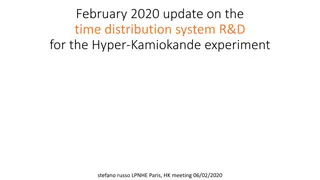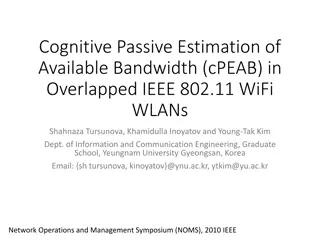Challenges and Requirements for Bandwidth Indication in IEEE 802.11
The document discusses challenges and requirements related to bandwidth indication in RTS/CTS frames with PPDU in 320 MHz, focusing on scenarios where bandwidth signaling may lead to misinterpretation by stations. It highlights the need for dynamic bandwidth and preamble puncturing information in RTS/CTS frames to accommodate evolving Wi-Fi standards. The goal is to address complex issues while maintaining backward compatibility and preparing for future advancements in the IEEE 802.11 protocol.
Download Presentation

Please find below an Image/Link to download the presentation.
The content on the website is provided AS IS for your information and personal use only. It may not be sold, licensed, or shared on other websites without obtaining consent from the author.If you encounter any issues during the download, it is possible that the publisher has removed the file from their server.
You are allowed to download the files provided on this website for personal or commercial use, subject to the condition that they are used lawfully. All files are the property of their respective owners.
The content on the website is provided AS IS for your information and personal use only. It may not be sold, licensed, or shared on other websites without obtaining consent from the author.
E N D
Presentation Transcript
Feb 2021 doc.: IEEE 802.11-21/0247r1 Bandwidth indication in RTS/CTS in 320 MHz PPDU and Punctured Preambles Date: 2021-02-27 Authors: Name Brian Hart Affiliations Address Cisco Systems Phone email brianh@cisco.com Pooya Monajemi Submission Slide 1 Brian Hart (Cisco Systems)
Feb 2021 doc.: IEEE 802.11-21/0247r1 Situation In D0.3, the MAC team poses an nearly-impossible problem for the PHY team: Section 9: In an RTS/PS-Poll/CF-End/NDPA frame transmitted by an EHT STA in a non-HT duplicate format with bandwidth greater than 160 MHz to another EHT STA, the TBD field in the SERVICE field carries the TXVECTOR parameter CH_BANDWIDTH_IN_NON_HT as in Table 36-1 (TXVECTOR and RXVECTOR parameters) and the TA field is a bandwidth signaling TA Yet there is no clause 17 work to insert such a field Probably because this is really hard: e.g. the 21/77 SP failed because it didn t address all concerns As we use the USIG for 11beR2 and future 802.11 amendments, we will likely define new PPDU bandwidths (etc) that benefit from single-user RTS/CTS protection, and the MAC team will demand more from the PHY team Since adding new information to RTS/etc frames sent in non-HT PPDUs without affecting NAV setting at legacy STAs is the most constrained problem in 802.11, the PHY team needs to solve the D0.3 puzzle, and do it with future proofing to avoid genuinely impossible problems down the road Need to start this process by asking: what are the R1 requirements, expected and potential R2 and Wi-Fi8 requirements? Submission Slide 2 Brian Hart (Cisco Systems)
Feb 2021 doc.: IEEE 802.11-21/0247r1 Known and Potential Requirements R1: Signal 320 MHz in RTS/PS-Poll/CF-End/NDPA frames sent in non-HT (dup) PPDUs Static preamble puncturing Requirements seem the same as for 320 MHz, but need to consider an unassociated STA sends an unpunctured 80/160 MHz RTS to an AP in a preamble-punctured BSS, and the AP responds with a CTS indicating the punctured subchannels are free but the STA interprets this as that the entire 80/160 MHz bandwidth is free (most concerning for 80/160 MHz in 5 GHz due to legacy). Resolvable via MAC rules or by including preamble puncturing information in RTS (and CTS for dynamic BW) (see Challenge 3 in backup) R1 or R2 according to perspective* *11be cannot avoid supporting features already defined by the 802.11 MAC, unless 11be explicitly deprecates them for 11beR1 and 11beR2 (but different members may have variations on this understanding) TBD: Dynamic bandwidth (320 MHz bandwidth conveyed in RTS and CTS) R2: TBD: Dynamic preamble puncturing (Signal the preamble puncturing mode in RTS) TBD: Dynamic preamble puncturing and dynamic bandwidth (Signal the preamble puncturing mode in RTS and CTS) Wi-Fi8 (and beyond) TBD: Signal 640 MHz (and beyond) in RTS/PS-Poll/CF-End/NDPA frames sent in non-HT (dup) PPDUs TBD: Dynamic bandwidth and/or dynamic preamble puncturing Submission Slide 3 Brian Hart (Cisco Systems)
Feb 2021 doc.: IEEE 802.11-21/0247r1 Why RTS+CTS in Non-HT PPDUs? They Support Many Desirable Features Feature Name Benefits Solution constraints Non-HT PPDU format; no change to RTS or CTS frame type/subtype or other contents, LSIG Reserved bit, non-HT Service field, etc (i.e. don t trigger any over-zealous checks by legacy impl*; e.g. legacy receiving ehtCTS might not set NAV) NAV set at all third-party 11a/g+ STAs Best possible TXOP protection NAV cancellation at all third- party STAs in 2.4/5GHz (11a/g+) If the RTS recipient sees a busy (primary) channel, other STAs can recycle the protected time after no CTS nor following PPDU Keep RTS frame type and subtypes NAV cancellation at all third- party STAs in 6GHz (HE+) If the RTS recipient sees a busy (primary) channel, other STAs can recycle the protected time after no CTS nor following PPDU Keep RTS/MU-RTS frame type and subtypes Dynamic bandwidth (with static preamble puncturing) If the RTS recipient sees busy secondary channel(s), it can respond with a lower bandwidth duplicated CTS, and the TXOP proceeds albeit at reduced BW RTS and CTS must be able to convey 320 MHz bandwidth; and possibly puncturing info for 80/160M PPDUs (see Challenge 3) Dynamic preamble puncturing (with static bandwidth) Greater medium time utilization in the presence of widespread dynamic interference (e.g. central OBSS) RTS must be able to convey preamble puncturing information (6 bits) Dynamic bandwidth and dynamic preamble puncturing Greater medium time utilization in the presence of localized dynamic interference (e.g. all OBSS) RTS and CTS must be able to convey preamble puncturing information (6 bits) Desirable if RTS bandwidth signaling with dynamic bandwidth is self-contained RTS can be sent between unassociated STAs; when an AP receives an RTS, it doesn t need to lookup the client capabilities within SIFS to interpret the RTS and form the correct CTS. Cannot just add new bits to scrambling sequence Submission Slide 4 Brian Hart (Cisco Systems)
Feb 2021 doc.: IEEE 802.11-21/0247r1 But the MAC team has options too: but at higher overhead than the PHY options 320 MHz bandwidths are only defined for 6 GHz where there are only HE STAs And HE STAs understand MU-RTS 320 MHz; so no loss of NAV cancellation (if new BW info can be shoehorned into MU- RTS) Does the MAC team really need bandwidth information in RTS/PS-Poll/CF-End/NDPA frames sent in non-HT PPDUs? Or can the MAC team just define new rules and new control frames that have room for bandwidth information instead? MAC protection For 320 MHz, always use MU-RTS+CTS For dynamic preamble puncturing, always MU-RTS+CTS But, for 80/160MHz in 5 GHz, 11a/HT/VHT STAs lose NAV cancellation For static preamble puncturing: a STA (unassociated or associated) cannot transmit a non-HT dup RTS to a recipient STA without first determining the statically punctured subchannels of the recipient STA (e.g. from the Beacon of the recipient STA s BSS), and then duplicating the non-HT RTS consistent with the statically punctured subchannels of the recipient STA PS-Poll: if used to start a wideband TXOP, define a new MAC control frame with bandwidth information CF-End: is it sufficient to receive this on a primary channel? (no BW information needed?) NDPA: is it sufficient to receive the EHT preamble of the NDP? See Open Discussion slide at end MAC fixes have higher overhead than PHY changes, so let s find least-worst PHY change Submission Slide 5 Brian Hart (Cisco Systems)
Feb 2021 doc.: IEEE 802.11-21/0247r1 Challenge 1 (aka why the 21/77 SP failed) For non-HT dup, First7BitsOfScramblingSequence does not easily generalize to 320 MHz, let alone TBD 11beR2/ Wi-Fi8 requirements Although more bits could be stolen from the scrambling sequence, there are not many left (reduces the PAPR robustness) All scrambling sequences are already allowed, so these stolen bits are already a mix of 0 and 1, so a recipient cannot reliably distinguish VHT/HE signalling from EHT signalling Consider the simple example of: The channel is a fully idle (for simplicity) An AP receives an RTS The scrambling sequence indicates 320 MHz if sent by an EHT STA, or 40 MHz if sent by a VHT/HE STA (for example, following the sample encoding in 20/616r0, slide 5) Once the TA in the RTS is decoded, the AP has to do a lookup to determine the STA capabilities to interpret the scrambling sequence SIFS later, the AP sends a 40 MHz or 320 MHz non-HT dup of CTS frames The lookup is onerous at the AP if it has 500 associated clients; and it precludes unassociated use cases such as protecting a 320 MHz NDPA+NDP 11az TXOP There are not enough bits in First7BitsOfScramblingSequence for all potential TBD 11beR2/ Wi- Fi8 requirements (e.g. dynamic preamble puncturing would be excluded) Submission Slide 6 Brian Hart (Cisco Systems)
Feb 2021 doc.: IEEE 802.11-21/0247r1 Challenge 2 (1/2) For dynamically preamble punctured PPDUs, if unable to carry preamble puncturing information in non-HT dup, RTS/CTS is unusable Problem 2a: The RTS sender dynamically preamble-punctures subchannel(s) in S20/S40/S80/S160 due to OBSS but how can the RTS recipient know this? RTS: CBW80 CBW80 does not tell the RTS recipient to ignore this OBSS subchannel OBSS RTS: CBW80 P20 RTS: CBW80 Submission Slide 7 Brian Hart (Cisco Systems)
Feb 2021 doc.: IEEE 802.11-21/0247r1 Challenge 2 (2/2) Problem 2b: A recipient of a RTS with dynamic preamble puncturing and dynamic bandwidth can only signal the clear P20/P40/P80/P160 MHz in its CTS Even if a smart RTS recipient can detect this duplicate RTS (with some error rate), it still can t tell the RTS sender RTS: CBW80 OBSS RTS: CBW80 CTS: CBW40 BA Data P20 RTS: CBW80 CTS: CBW40 BA Problem 2c: Even if a) the RTS recipient attempts to detect duplicate non-primary RTSs and then sends CTS frames on all RTSed and idle subchannels and b) the CTS recipient attempts to detect duplicate non-primary CTSs, this process is unreliable due to false misses from frequency selectivity (especially for single-antenna devices) and false alarms from OBSS transmissions, and leads to untestableheuristics i.e. unpredictable and variable behavior (game of telephone ), yet RTS+CTS needs to just work . Submission Slide 8 Brian Hart (Cisco Systems)
Feb 2021 Solutions Option A: Non-HT Service field? doc.: IEEE 802.11-21/0247r1 Assume we can ignore legacy implementations that only continue to process a non-HT PPDU if the last 9b of its Service field are 0s Perhaps this be true in 6 GHz, but with no good solution for 5 GHz? For R1 insert 320MHz indication (with room for 6-9b of Preamble Puncturing Info in R2 if needed) in the non-HT PPDU s Service field If needed, preamble puncturing could need 33-37 values defined (see backup) Since no CRC protects this field, also add 3-0b of Parity/CRC i.e. trade-off between future-proofing and reliability Note: we expect that this option is precluded by legacy implementations Submission Slide 9 Brian Hart (Cisco Systems)
Feb 2021 doc.: IEEE 802.11-21/0247r1 Solutions Option B: OFDSA of non-HT PPDUs Change clause 36 to define: Orthogonal frequency-multiplexed, different non-HT PPDUs OFDSA of non-HT PPDUs on DL, OFDSA/ simulcast -OFDSA of non-HT PPDUs on UL ( SA = single access) When an AP transmits RTS to SST clients, need to consider UL OFDMA of non-HT PPDUs (see 20/1583) Must be mandatory for both TX and RX, for both APs and non-AP STAs 320 MHz via 160 MHz non-HT-dup + 160 MHz non-HT-dup (2 decoding operations for dynamic BW) If dynamic preamble puncturing is a goal, due to the number of preamble puncturing patterns, this suggests 1 decoding operation per 20 MHz in the primary 80 MHz, and one decoding operation per 40 MHz in the remaining PPDU bandwidth (so 320 MHz implies 10 decoding operations). Note: this is a new requirement on non-AP STAs, and may be unacceptable (certainly for dynamic preamble puncturing) RTS: CBW20 CTS: CBW20 BA Data OBSS RTS: CBW40 CTS: CBW40 BA Data P20 RTS: CBW40 CTS: CBW40 BA Submission Slide 10 Brian Hart (Cisco Systems)
Feb 2021 Solutions Option C1: Uncoded Pad bits with Tail RTS, CF-End and PS-Poll are 20 octets; CTS is 14 octets When transmitted in a non-HT PPDU, the number of uncoded Pad bits is always at least 10 bits (and assume NDPA can be padded to ensure this) Can fit 3 bits of BW indication, (odd) Parity bit and a 6-bit Tail into 10 pad bits Akin to HESIGB No room for dynamic preamble puncturing Two ways to insert the new fields into the uncoded Pad field: Before the scrambler (for PAPR robustness; and use odd parity so it is non-zero by design to indicate the presence of the new fields) After the scrambler Sample encoding Scrambling sequence indicates 20-80MHz: nothing inserted Scrambling sequence indicates 160MHz and means 160MHz: ? Scrambling sequence indicates 160MHz but doesn t mean it: Insert new fields, where the 3-bit BW field is 0: BW = 320 MHz 1-7: Reserved (for future amendments) doc.: IEEE 802.11-21/0247r1 Non-HT (Mbps) nPad (RTS, CF- End or PS-Poll @ 20B) nPad (CTS @ 14B) 6 10 10 9 34 10 12 10 10 18 34 10 24 10 58 36 106 10 48 10 58 54 34 82 Data bits Append Tail, Pad Overwrite Pad with BW Info Scramble Overwrite Tail x2 with zeros Encode + Puncture Interleave Submission Slide 11 Brian Hart (Cisco Systems)
Feb 2021 Solutions Option C2: Uncoded Pad bits sans Tail doc.: IEEE 802.11-21/0247r1 Non-HT (Mbps) nPad (RTS, CF- End or PS-Poll @ 20B) nPad (CTS @ 14B) 6 10 10 Like Option C1, the number of uncoded Pad bits is always at least 10 bits Here we use more of them to carry data, enough so it is possible to carry preamble puncturing information as well as BW Two ways to insert the new fields into the uncoded Pad field: Before the scrambler (for PAPR robustness; and non-zero by design to indicate the presence of the new fields) After the scrambler (for simpler decoding; also allocate 1b to indicate the presence of the new fields) Note: oftentimes later data bits get fewer coded bits i.e., whenever nPad 10 + nTail; e.g., 6, 12 Mbps are bad, 54 Mbps is good Sample contents: B0 = !ScrambledPad at this bit position; B1-7 = BW+PreamblePunc Info with values 0 (320M) defined in R1 and 1-36 available for preamble puncturing in R2 if needed, and the rest reserved for future amendments; B8 =parity, B9 = reserved for future use. 9 34 10 12 10 10 18 34 10 24 10 58 36 106 10 48 10 58 54 34 82 Data bits Append Tail, Pad Overwrite Pad with BW+PreaPunc Info BTW, conceptually an optimal EHT receiver processes the L = min(10+nTail,nPad)/R 32 LLRs after the Tail field like an unstructured block code. For each of the allowed sequences, calculate an inner product between the length-L LLR vector and each of the allowed pre-calculated codeword vectors (entries are 1); then pick the sequence with the maximum inner product. Oftentimes later bits are less reliable Scramble Overwrite Tail with zeros Encode + Puncture Interleave Submission Slide 12 Brian Hart (Cisco Systems)
Feb 2021 Solution Option D: Coded Pad bits doc.: IEEE 802.11-21/0247r1 Non-HT (Mbps) nPadCoded (RTS, CF-End or PS-Poll @ 20B) nPadCoded (CTS @ 14B) 6 20 20 9 45 13.333 [13] If we disallow 9, 18 and 36 Mbps CTS before 320 MHz and/or preamble punctured PPDUs, then at least 20 coded bits are available from the coded Pad field If we redefine these coded bits as data bits then they lack coding gain (and a checksum) Two ways to insert the new fields into the coded Pad field: XOR the coded Pad field with the new fields (for PAPR robustness; and non-zero by design to indicate the presence of the new fields) Overwrite the coded Pad field (at the cost of PAPR robustness; also need to allocate 1b to indicate the presence of the new fields) Sample contents: 7b for Bandwidth and Puncturing Information 12 20 20 18 45 13.333 [13] 24 20 116 36 141.333 13.333 [13#] 48 15 87 54 45.333 109.333 [13] Data bits Append Tail, Pad Scramble Overwrite Tail with zeros Encode + Puncture With 1 value defined in R1 (320M), 37 values available for dynamic preamble puncturing if needed and the rest reserved for future amendments and the values starting at 1 so these new fields are never all-zeros 1b for future proofing 2b CRC Either BCC r1/2 encoded with tail biting, simple repetition or block code Many other trade-offs between data, error detection coding and error correction coding are possible. XOR (or overwrite) with (scrambled) BW+Punc Info Interleave Submission Slide 13 Brian Hart (Cisco Systems)
Feb 2021 doc.: IEEE 802.11-21/0247r1 Open Discussion What is the least worst PHY option: Option A: Non-HT Service field (Risks from legacy) Option B: OFDSA of non-HT PPDUs (320 via 160+160 may be OK; dynamic preamble puncturing is surely too onerous to non-AP STAs) Option C1: Uncoded Pad bits with Tail (Enough bits for BW information, but not dynamic preamble puncturing) Option C2: Uncoded Pad bits sans Tail (Later bits get less coding gain whenever only 10 Pad bits) Option D: Coded Pad bits or Option E: Another PHY proposal ? Given the least worst option above, double check if MAC team really needs a 320M BW indication in RTS/PS-Poll/CF-End/NDPA frames from PHY Or can live with new(ish) control frames such as MU-RTS, PS-Poll-with-BW, etc Some of these options are HW impacting for some R1 implementations, so we should close on this topic fairly quickly Submission Slide 14 Brian Hart (Cisco Systems)
Feb 2021 doc.: IEEE 802.11-21/0247r1 Backup Submission Slide 15 Brian Hart (Cisco Systems)
Feb 2021 doc.: IEEE 802.11-21/0247r1 References 21/77, Yunbo/Huawei, signal 320M via B3/5/6 of the scrambling sequence SP failed 21/60, Yunbo/Huawei, modified MU-RTS format (punc info in Common Info field) 20/1583, Jarkko/Apple, RTS/CTS for SST (optional RX of OFDMA of non-HT) 20/1281, Kaiying/MDK Adopted into D0.3 20/616, Yunbo/Huawei, signal 240/320M via B3/5/6 of the scrambling sequence SP to use scrambling seq passed; SP for a particular encoding failed 20/62, Liwen/NXP, either define enhancedRTS, enhancedCTS or evolve NDPA/Trigger frame 19/2125, Yongho/MDK, define ehtRTS, ehtCTS SP to use MU-RTS/RTS/CTS on non-punctured 20M subchannels passed Submission Slide 16 Brian Hart (Cisco Systems)
Feb 2021 doc.: IEEE 802.11-21/0247r1 Challenge 3 Even if preamble puncturing is static, if an unassociated STA sends an unpunctured 80/160 MHz RTS to an AP in a preamble-punctured BSS, and the AP responds with a CTS indicating the punctured subchannels are free then the STA will interpret this as the entire 80/160 MHz bandwidth being idle (affects 80/160 MHz in 5 GHz). Options: PHY: RTS and CTS include preamble puncturing information. MAC: Require that unassoc STAs do not transmit wider than 20MHz to another STA without first ascertaining that STA s static preamble puncturing status; and then transmit a non-HT dup RTS to the STA consistent with that STA s preamble puncturing CTS: CBW80 BA? RTS: CBW80 Persistent interferer causes AP to statically disable this subchannel RTS: CBW80 Data CTS: CBW80 BA? RTS: CBW80 CTS: CBW80 BA? P20 RTS: CBW80 AP alerts BSS; CBW80 is used intra-BSS to signal the 3 unpunctured subchannels within 80 MHz Unassoc STA sends 80 MHz non-HT dup RTS to AP AP assumes the RTS arises within its BSS (so didn t include a dup on the disabled subchannel) and so the AP responds with a punctured CTS Unassoc STA interprets CBW80 as that the entire 80 MHz is available, so transmits on the disabled subchannel! Submission Slide 17 Brian Hart (Cisco Systems)
Feb 2021 doc.: IEEE 802.11-21/0247r1 Challenge 4 (Relates to work in 20/1583 but orthogonal to most of this presentation) For an MU-RTS + simulcast CTS exchange, physics severely constrains how bandwidth information can be solicited from MU-RTS recipients: Fundamentally, multiple responders to MU-RTS transmitting on the same 20 MHz must not signal different information (specifically, PPDU bandwidth / preamble puncturing information) Options: If the RTS sender monitors P20 only Just one responder, or Responders only transmit CTS (on whatever subchannels) if all subchannels indicated by the RTS are idle (i.e. static case, with full bandwidth sensing so ill-suited to SST) If the RTS sender can separately receive the non-HT CTSs sent on each max(RU size, 20 MHz) as if it was one part of collective UL OFDMA of non-HT Just zero or one responder per 20 MHz, or Responders detect their subchannels are idle (which may be less than the dup RTS bandwidth) and spoof that all the 20 MHz subchannels of the dup RTS are idle in their CTS transmissions (e.g. for the SST use case) Submission Slide 18 Brian Hart (Cisco Systems)
Feb 2021 doc.: IEEE 802.11-21/0247r1 Background (1/2) RTS+CTS sent in non-HT PPDU format provides maximum protection Understood by all 11a/g STAs onwards Also RTS+CTS uniquely offers the NAV cancellation feature at all third-party STAs RTS + no CTS + no Data frame cancel the NAV set by the RTS MU-RTS offers equal protection at 6 GHz since HE STAs only (but higher overheads) A non-HT dup PPDU does not natively signal its own duplicated, punctured bandwidth VHT added a static/dynamic bandwidth mode: Static bandwidth: if all the RTS subchannels are clear at an intended recipient, the recipient sends CTS over all the subchannels; and otherwise sends nothing Dynamic bandwidth: if some of the RTS subchannels overlapping P20 are clear at an intended recipient, considering the allowed bandwidths of P20/P40/P80/160, the recipient sends a duplicated CTS over the widest allowed bandwidth; and otherwise sends nothing i.e. a) in both cases, the RTS recipient needs to know on which channels the RTS is duplicated, b) in the dynamic case, the CTS recipient needs to know on which channels the CTS is duplicated Submission Slide 19 Brian Hart (Cisco Systems)
Feb 2021 doc.: IEEE 802.11-21/0247r1 Background (2/2) Various legacy implementations may have checked frame type/subtype fields, RTS fields, CTS fields, the Reserved bit in the LSIG and/or the zero bits in a non-HT PPDU s Service field to reduce the likelihood of interpreting noise / interference as a valid non-HT PPDU Even if not an intended recipient of an RTS or CTS, if third party STAs stop processing the RTS or CTS, then their NAV doesn t get set which defeats the purpose of RTS+CTS/CTS2self Clause 17 defines the Pad bits as scrambled zeros. HE implementations must follow clause 17 exactly for CTS after MU-RTS Accordingly VHT used: The First7BitsOfScramblingSequence to carry 2b of bandwidth information and 1b of static/dynamic indication, and The I/G bit in the TA in the RTS to indicate that the First7BitsOfScramblingSequence carries these bandwidth-related indications This protocol was not updated by HE, given no new bandwidths were defined Preamble puncturing was new, but this feature was added late and remained optional Submission Slide 20 Brian Hart (Cisco Systems)
Feb 2021 doc.: IEEE 802.11-21/0247r1 Preamble Puncturing Modes If needed, dynamic preamble puncturing signaling requires 6b minimum: And 11be should leave room for future amendments Bandwidth (MHz) 20 40 Count (New) 1 (0) 1 (0) Preamble puncturing modes N/A N/A YYYY; nYYY, YnYY, YYnY, YYYn 80 5 (4) YYYYYYYY; nnYYYYYYY, YYnnYYYY, YYYYnnYY, YYYYYYnn YYYYYYYYYYYYYYYY; nnnnYYYYYYYYYYYY, YYYYnnnnYYYYYYYY, YYYYYYYYnnnnYYYY, YYYYYYYYYYYYnnnn; nnYYYYYYYYYYYYYY, YYnnYYYYYYYYYYYY, YYYYnnYYYYYYYYYY, YYYYYYnnYYYYYYYY, YYYYYYYYnnYYYYYY, YYYYYYYYYYnnYYYY, YYYYYYYYYYYYnnYY, YYYYYYYYYYYYYYnn; nnnnnnYYYYYYYYYY, nnnnYYnnYYYYYYYY, nnnnYYYYnnYYYYYY, nnnnYYYYYYnnYYYY, nnnnYYYYYYYYnnYY, nnnnYYYYYYYYYYnn; nnYYYYYYYYYYnnnn, YYnnYYYYYYYYnnnn, YYYYnnYYYYYYnnnn, YYYYYYnnYYYYnnnn, YYYYYYYYnnYYnnnn, YYYYYYYYYYnnnnnn 160 5 (4) 320 25 (25) Total 37 (33) Submission Slide 21 Brian Hart (Cisco Systems)
